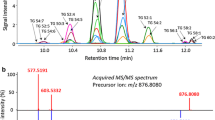Abstract
The yeast forms of four strains ofParacoccidioides brasiliensis (SN, 2, 18, and 192), maintained in the laboratory for a long period of time, and a recent isolate of this fungus (JT-1) were cultured in a synthetic medium. Cell masses of each strain, in exponential growth phase, were obtained and lyophilized for partial analysis of their biochemical composition. The lipids of the five strains were extracted, purified, and analyzed in relation to the presence of sterols, phospholipids, glycolipids, and lipoproteins. The material withdrawn during the purification phase (“supernatant of lipid purification”) was subjected to protein and carbohydrate measurements. Another subfraction, lipid-free yeast, was analyzed after cell rupture by sonication, in relation to protein and carbohydrate total contents. The results showed significant differences in the measurements of total lipids (6.6–13.2 mg%), phospholipids (0.19–0.77 mg%) and glycolipids (0.14–0.42 mg%) among the five strains. Sterol analysis revealed the presence of ergosterol, lanosterol, and squalene in all of the samples. The measurements carried out on the supernatants of lipid purification and in the lipid-free yeasts also showed differences among the studied strains, particularly in relation to total carbohydrate content, which was significantly higher in the recent isolate of the fungus (JT-1). As a whole, this study revealed the existence of relevant biochemical differences among these differentParacoccidioides brasiliensis strains.
Similar content being viewed by others
Literature Cited
Breivick ON, Owades JL (1957) Spectrophotometric semimicro-determination of ergosterol in yeast. J Agric Food Chem 5:360–363
Brummer E, Restrepo A, Hanson LH, Stevens DA (1990) Virulence ofParacoccidioides brasiliensis: the influence of “in vitro” passage and storage. Mycopathologia 109:13–17
Castañeda E, Brummer E, Perlman AM, McEwen JG, Stevens DA (1988) A culture medium forParacoccidioides brasiliensis with high plating efficiency and effect of siderophores. J Med Vet Mycol 26:351–358
Chen PS, Toribara TY, Warner H (1956) Microdetermination of phosphorus. Anal Chem 28:1756–1758
Conti-Diaz IA, Rodriguez H (1990) Paracoccidioidomicosis: aspectos clinicos. Interciência 15:224–226
Fava Netto C (1955) Estudos quantitativos sobre a fixação do complemento na blastomicose sul-americana, com antigeno polissacaridico. Arq Cir Clin Exper 18:197–254
Fava Netto C (1990) Antigeno polissacaridico deParacoccidioides brasiliensis. Interciência 15:209–211
Fava Netto C, Vegas VS, Scianaméa IM, Guarnieri DB (1969) Antigeno polissacaridico deParacoccidioides brasiliensis: estudo do tempo de cultivo doParacoccidioides brasiliensis, necessário ao preparo do antigeno. Rev Inst Med Trop São Paulo 11:177–181
Franco M (1987) Host-parasite relationships in paracoccidioidomycosis. J Med Vet Mycol 25:5–18
Hamdan JS (1991) Frações bioquímicas deParacoccidioides brasiliensis e seu papel na gênese da doença causada por este microrganismo. Estudo experimental em camundongos. Ph.D. Thesis, Universidade Federal de Minas Gerais, Belo Horizonte
Hamdan JS, Resende MA (1988) Lipid composition and effect of amphotericin B on yeast cells ofParacoccidioides brasiliensis. Mycopathologia 102:97–105
Hamdan JS, Rocha RL (1987) Epidemiologia da paracoccidioidomicose. An Fac Med Univ Fed Minas Gerais 36:52–61
Hunter K, Rose AH, (1972) Lipid composition ofSaccharomyces cerevisiae as influenced by growth temperatures. Biochim Biophys Acta 260:639–653
Kanetsuna F (1967) Estudio bioquimico delParacoccidioides brasiliensis. Acta Cient Venez 3:308–317
Kashino SS, Calich VL, Singer-Vermes LM, Abrahamsohn P, Burger E (1987) Growth curves, morphology and ultrastructure of tenParacoccidioides brasiliensis isolates. Mycopathologia 99:119–128
Kim SJ, Kwon-Chung KJ (1974) Polyene-resistant mutants ofAspergillus fennelliae: sterol contents and genetics. Antimicrob Agents Chemother 6:102–113
Letters R (1968) Phospholipids of yeasts. In: Mills AE (ed) Aspects of yeast metabolism. Oxford: Blackwell Scientific Publications, pp 303–319
Lowry OH, Rosenbrough NJ, Farr A, Randall RJ (1951) Protein measurement with the folin phenol reagent. J Biol Chem 193:265–275
Manocha MS (1980) Lipid composition ofParacoccidioides brasilliensis: comparison between the yeast and mycelial forms. Sabouraudia 18:281–286
Manocha MS, San-Blás G, Centeno S (1980) Lipid composition ofParacoccidioides brasiliensis: possible correlation with virulence of different strains. J Gen Microbiol 117:147–154
Montenegro MR, Franco M, Mendes RP (1988) Paracoccidioidomycosis: clinical forms. Proceedings of the X Congress of the International Society for Human and Animal Mycology-ISHAM 1988:149–153
Moore PR, Baumann CA (1952) Skin sterols. I. Colorimetric determination of cholesterol and other sterols in skin. J Biol Chem 195:615–621
Resende MA, Alterthum F (1990) Effect of nystatin, amphotericin B and amphotericin B methyl ester onSaccharomyces cerevisiae with different lipid composition. Mycopathologia 112:165–172
Restrepo A, Cano LE, Ochoa MT (1984) A yeast-derived antigen fromParacoccidioides brasiliensis useful for serologic testing. J Med Vet Mycol 22:23–29
Restrepo AM, Jimenez BE (1980) Growth ofParacoccidioides brasiliensis yeast phase on a chemically defined culture medium. J Clin Microbiol 12:279–281
San-Blás F, Castañeda E (1990) Biologia deParacoccidioides brasiliensis. Interciência 15:212–215
Scott TA, Melvin EH (1953) Determination of dextran with anthrone. Anal Chem 25:1656–1661
Silva CL (1985) Granulomatous reaction induced by lipids isolated fromParacoccidioides brasiliensis. Trans R Soc Trop Med Hyg 79:70–73
Silva CL, Fazioli RA (1985) AParacoccidioides brasiliensis polysaccharide having granuloma inducing, toxic and macrophage-stimulating activity. J Gen Microbiol 131:1497–1501
Singer-Vermes LM, Burger E, Franco MF, Bacchi MM, Mendes-Giannini MJ, Calich VL (1989) Evaluation of the pathogenicity and immunogenicity of sevenParacoccidioides brasiliensis isolates in susceptible inbred mice. J Med Vet Mycol 27:71–82
Teixeira HC, Calich VL, Singer-Vermes LM, D'Imperio-Lima MR, Russo M (1987) Experimental paracoccidioidomycosis: early immunosuppression occurs in susceptible mice after infection with pathogenic fungi. Braz J Med Biol Res 20:587–589
Villar LA, Restrepo A (1989) Virulence of a variant ofParacoccidioides brasiliensis that exists in the yeast form at room temperature. J Med Vet Mycol 27:141–148
Zacharias D, Ueda A, Moscardi-Bacchi M, Franco M, SanBlás G (1986) A comparative histopathological, immunological and biochemical study of experimental intravenous paracoccidioidomycosis induced in mice by threeParacoccidioides brasiliensis isolates. J Med Vet Mycol 24:445–454
Author information
Authors and Affiliations
Rights and permissions
About this article
Cite this article
Hamdan, J.S., Resende, M.A., Cunha, A.L. et al. Partial biochemical characterization of fiveParacoccidioides brasiliensis strains. Current Microbiology 27, 91–95 (1993). https://doi.org/10.1007/BF01570864
Issue Date:
DOI: https://doi.org/10.1007/BF01570864




